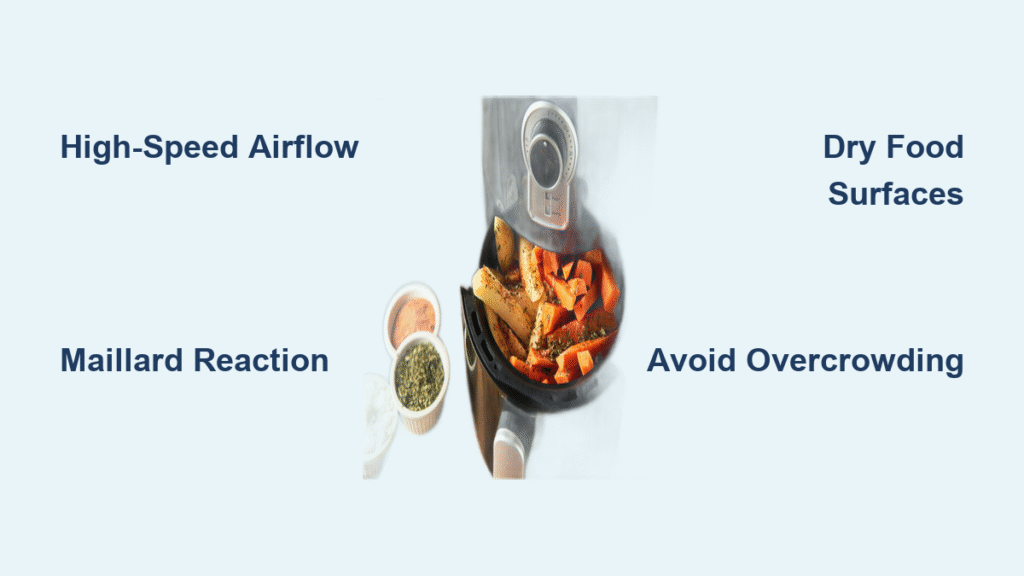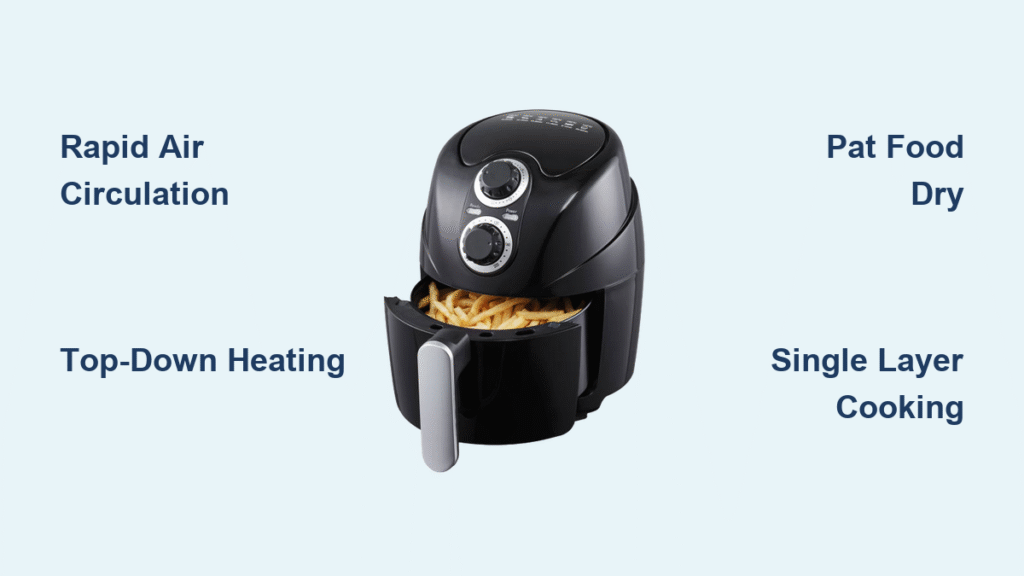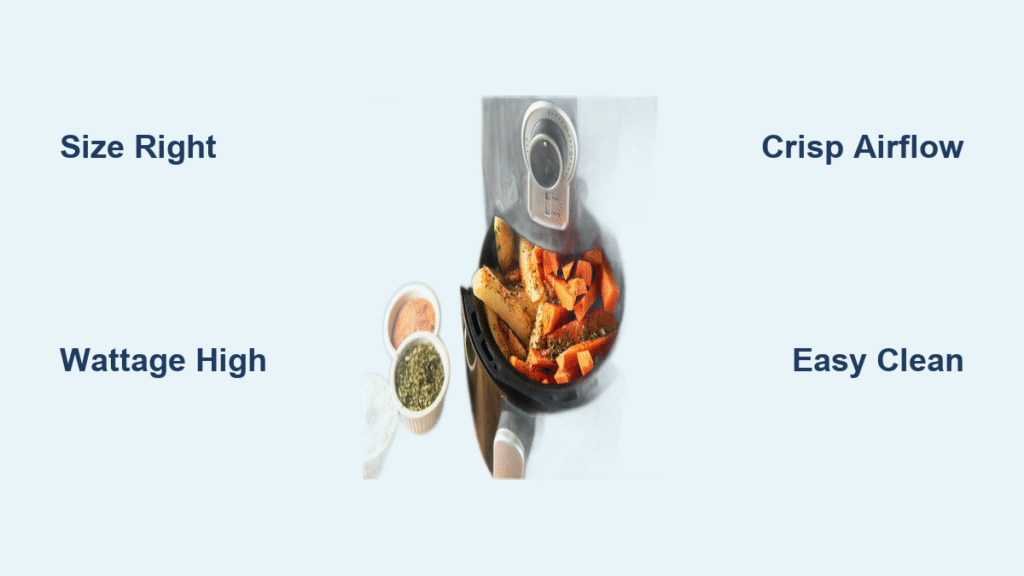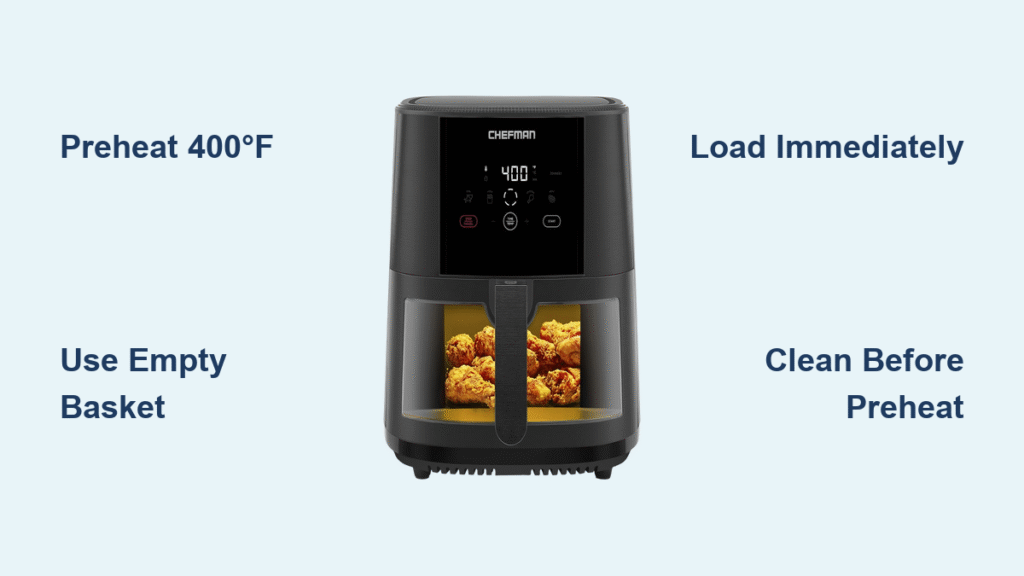Your air fryer isn’t actually frying anything. That countertop box promising crispy fries with minimal oil is really a turbocharged convection oven using precise physics to mimic deep-frying results. Within minutes of pressing start, it blasts food with 400°F air moving faster than a hair dryer on max setting, triggering the Maillard reaction that creates golden-brown exteriors and complex flavors. Understanding how does an air fryer work reveals why your chicken skin crackles and fries stay crisp—no oil bath required. This guide breaks down the engineering secrets, temperature science, and airflow tricks that transform your leftovers into restaurant-quality meals in minutes.
Air Fryer Core Mechanism
High-Velocity Hot Air Engine
Inside every air fryer, a powerful heating coil positioned directly above your food pumps out intense radiant heat. A high-speed fan (typically 1,500-2,000 watts total power) forces this superheated air downward at hurricane speeds, creating a continuous convection current that surrounds every food surface. The perforated basket isn’t decorative—it’s engineered with strategic channels and mesh patterns to ensure 360° airflow while eliminating dead zones. This combination of direct radiant heat and forced convection creates rapid air technology, which simultaneously dehydrates food surfaces and transfers heat 2-3x faster than conventional ovens.
Critical Temperature Sweet Spot
Your air fryer operates between 300-400°F for optimal results, hitting the minimum 320°F threshold required for proper browning. At these temperatures, the Maillard reaction—the chemical process responsible for complex flavors and golden crusts—accelerates dramatically. Premium models may reach 662°F, but this extreme heat is rarely necessary for home cooking. The magic happens when rapid air circulation strips away the thin layer of cool air surrounding food (the boundary layer), allowing direct heat contact that sears surfaces while keeping interiors juicy. This physics-based approach explains why your salmon fillet develops a crisp skin in 10 minutes without drying out.
Design Types & Performance Differences
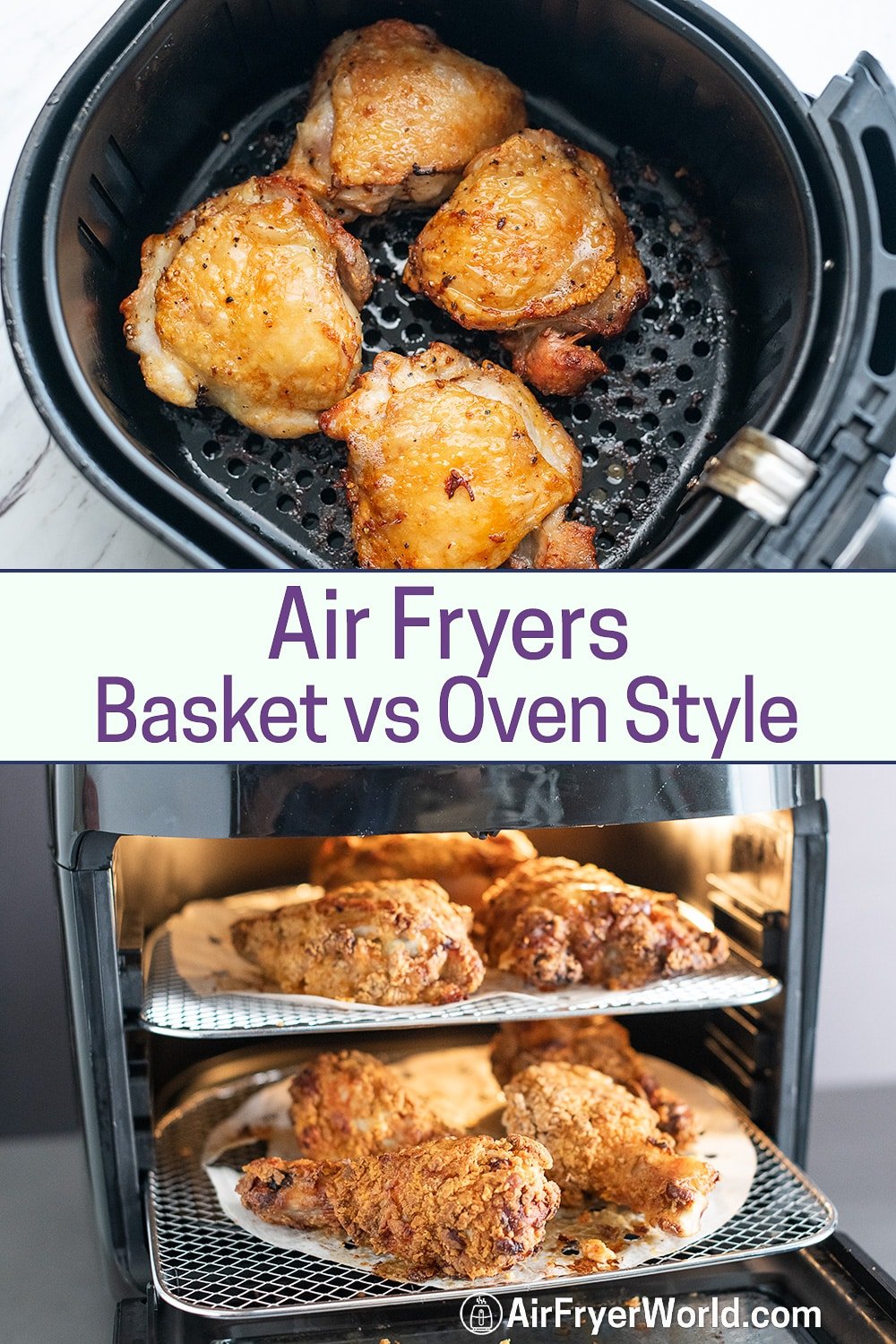
Basket vs Oven Styles
Standalone basket models heat up in under 60 seconds due to their compact chambers but offer limited functions. Countertop oven hybrids take 3-5 minutes to preheat but handle baking, broiling, and dehydrating with larger capacities. Built-in range versions eliminate countertop clutter but require 15+ minute preheats. The critical difference lies in airflow dynamics: basket styles create intense, focused circulation ideal for single-layer foods like wings, while oven styles distribute heat more evenly across multiple racks—essential when cooking casseroles or layered dishes.
Airflow Engineering Explained
Air fryers pack a fan-to-chamber ratio 2-3x higher than standard convection ovens. This engineering choice means your potato wedges experience jet-engine-force air instead of gentle breezes, accelerating cooking by 40-60%. The small chamber volume requires less energy to heat, while the fan’s strategic placement above the food creates a vortex effect. As hot air hits the food, it’s forced downward through the perforated basket, then sucked back up the sides to repeat the cycle. This relentless circulation evaporates surface moisture instantly—preventing steaming and enabling that signature crispness deep fryers achieve through oil immersion.
Speed Science Behind Browning

Why 15-Minute Wings Beat 45-Minute Oven Wings
Your air fryer’s tiny cooking chamber (typically 2-7 quarts) heats air 3x faster than a full-size oven. Combined with the high-velocity fan, this setup strips away the boundary layer of cool air surrounding food, allowing immediate heat transfer. The result? Surface temperatures hit browning thresholds in minutes rather than tens of minutes. This rapid dehydration accelerates Maillard reactions while convection currents prevent steam buildup—so chicken wings develop crackling skin in 22 minutes at 400°F instead of becoming soggy in a conventional oven.
Moisture Management Magic
Traditional ovens trap steam against food surfaces, creating rubbery textures. Your air fryer’s constant circulation acts like a microscopic hairdryer, evaporating moisture the moment it forms. This explains why reheated pizza emerges crispy—not limp—within 4 minutes. For starchy foods like potatoes, surface moisture removal allows starches to caramelize directly into a crisp crust rather than forming a soggy barrier. The perforated basket ensures this moisture escapes downward instead of recirculating, a critical design feature missing in standard toaster ovens.
Oil Reality Check
Actual Oil Usage Breakdown
Deep fryers require 2-4 cups of oil to submerge food, while air fryers need zero to 2 teaspoons—just enough to help seasonings adhere. Even when you add oil, foods absorb far less because the oil stays on the surface rather than penetrating food fibers. A 1-pound batch of fries typically uses 1-1.5 tablespoons of oil in an air fryer versus 3-4 cups in a deep fryer. Crucially, properly heated deep fryers absorb less oil than people assume (only 8-25% of submerged oil), so the calorie difference is smaller than marketing claims suggest.
Health Impact Truth
The real health advantage isn’t dramatic calorie reduction but three key factors: eliminating reused frying oil (which develops harmful compounds like acrylamides), reducing saturated fat exposure from oil absorption, and enforcing portion control. Since air fryers can’t handle massive batches, you naturally cook smaller servings. Additionally, the rapid cooking time preserves water-soluble vitamins better than boiling—making roasted broccoli nutritionally superior to boiled versions.
Foods That Shine vs Fail

Star Performers
Chicken wings develop crackling skin at 400°F in 22 minutes. Potato wedges achieve deep-fried texture with just 1 teaspoon oil per pound. Salmon fillets cook through in 10 minutes while staying moist inside. Broccoli florets caramelize at the edges while staying tender-crisp. Pro tip: Always pat proteins bone-dry before cooking—surface moisture is the enemy of crispiness and creates steam that impedes browning.
Guaranteed Disasters
Wet batters like beer-battered onion rings drip through perforations and scorch on the heating element. Leafy greens like spinach get blown against hot coils and burn instantly. Plain cheese melts into a sticky puddle on the basket mesh. These failures stem from physics mismatches, not user error—air fryers require foods with structural integrity to withstand hurricane-force air.
Capacity Constraints Explained
Batch Size Reality
A 4-quart basket realistically feeds 2-3 people; 6-quart models handle 4 max. Overcrowding blocks airflow paths, creating uneven cooking and soggy spots. The ½ to ⅔ full rule isn’t arbitrary—it’s the minimum clearance needed for air to circulate freely around every piece. Critical strategy: For large groups, cook multiple small batches instead of one massive pile. Your food will crisp faster, cook more evenly, and require less shaking—saving time despite the extra cycle.
Cleaning & Maintenance
Post-Cook Protocol
- Unplug immediately—residual heat continues cooking and can warp components
- Cool 15-30 minutes before handling (never immerse hot parts in water)
- Remove dishwasher-safe baskets for effortless cleanup (most non-stick coatings tolerate gentle cycles)
- Wipe interior walls with a damp cloth while warm (not hot) to dissolve grease before it hardens
Critical warning: Avoid aerosol spray oils—they contain soy lecithin that creates stubborn, gummy residue requiring steel wool scrubbing. Use pump sprayers with pure oils instead.
Advanced Techniques
Reheating Revolution
Leftover french fries regain their crunch in 3-4 minutes at 375°F—far superior to microwave mush. Pizza slices crisp perfectly at 350°F for 3-4 minutes without drying out toppings. The key is placing foods directly on the basket (not racks) to maximize surface contact with circulating air.
Dehydration Mode
Multi-function models with 105-175°F ranges transform apple slices into chips or create beef jerky. The consistent low temperature and airflow eliminate moisture without cooking the food. For best results, slice ingredients uniformly thin (⅛-inch) and rotate trays halfway through the 6-12 hour process.
Realistic Expectations
Texture Limitations
Your air-fried chicken won’t have the paper-thin shatter of perfect deep-fried versions. The crust is crispy but slightly thicker due to less oil penetration—often preferable for home cooking as it stays crisp longer. This isn’t failure; it’s a different culinary outcome optimized for convenience and health.
Noise & Space Reality
Expect 60-70 decibels of fan noise—conversation-level but noticeable in quiet kitchens. Counter space requirements vary dramatically: compact 2-quart models fit under cabinets, while 7-quart beasts dominate countertops. Always measure your space before buying, especially if storing under cabinets.
Quick-Start Mastery
Perfect First Cook
- Preheat 2-3 minutes at 380°F (critical for consistent results)
- Dry 1 pound potato wedges thoroughly, toss with 1 teaspoon oil + salt
- Arrange in single layer with space between pieces (no touching)
- Cook 15-18 minutes, shaking basket halfway for even exposure
- Serve immediately—crispness fades within 5 minutes as moisture redistributes
Temperature Cheat Sheet
- Frozen fries: 380°F, 15-20 min (shake at 10 min)
- Chicken thighs: 400°F, 22-25 min (flip at 15 min)
- Salmon fillets: 400°F, 10-12 min skin-side down
- Brussels sprouts: 375°F, 12-15 min (toss with ½ tsp oil)
Mastering how does an air fryer work transforms you from a button-pusher into a precision cook. By leveraging its rapid hot-air vortex, you trigger Maillard reactions faster than conventional ovens while using minimal oil. Remember the golden rules: never overcrowd the basket, always dry food surfaces, and embrace its speed for small-batch perfection. Though it won’t replicate wet-battered classics, your air fryer excels at resurrecting leftovers, roasting veggies, and delivering crispy proteins with restaurant flair—all in under 20 minutes. The real magic isn’t in the marketing—it’s in the physics of heat, air, and timing working in perfect harmony on your countertop.

